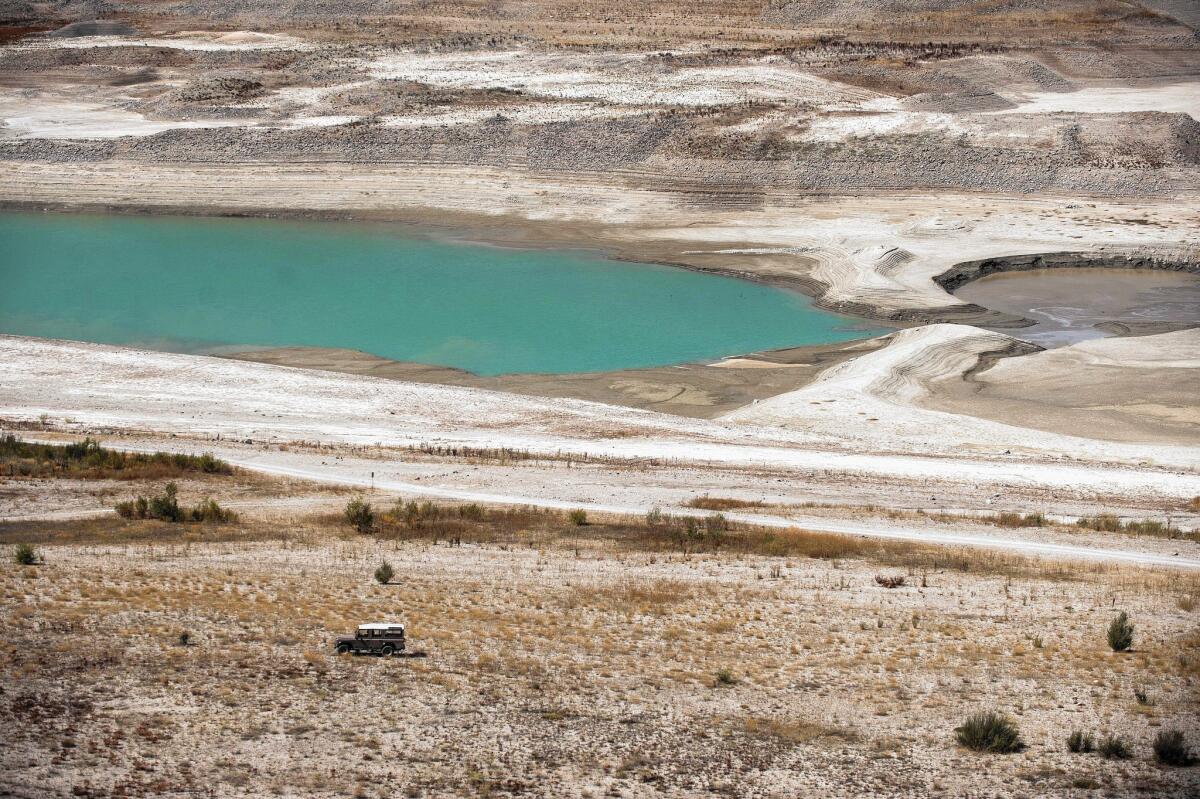Iran prays for rain amid acute water shortage

- Share via
Reporting from Tehran — The ritual chants of “Death to America!” have not gone away, but at Friday services across Iran worshipers sought divine intervention in a matter more climatological than ideological.
The faithful prayed for rain, or at least were urged to do so.
“For God’s sake, let’s go to God’s door and ask his Almighty to send water,” an animated Ayatollah Kazem Sedighi implored worshipers on the campus of Tehran University, the traditional venue of nationally televised Friday prayers.
Occasionally breaking into sobs, the ayatollah exhorted members of the congregation to make their pleas both to the Creator and to Imam Hussein, a revered figure in Shiite Muslim tradition. The water shortages afflicting Iran, Sedighi suggested, could be a heavenly nudge aimed at getting sluggish believers to pay a little more attention to matters of the spirit.
“God sometimes sends ordeals to make his followers seek him out by praying and avoiding sin,” he told worshipers, adding his own view that the divine reprimand, if that’s what it is, stretched the limits of fair play. “Iran has dedicated lots of martyrs to God and does not deserve a shortage of water,” Sedighi asserted.
Concern is mounting about dwindling water supplies across Iran, from the densely populated, smog-ridden capital and its parched suburbs to provincial towns and cities to far-flung corners of the nation, much of which is desert. Lakes and rivers have been drying up, reservoirs are at historic lows and water supplies have been cut in some areas. The annual snowmelt from the mountains is on the decline.
On the streets here, people grumble about cuts in water service. Many buildings have tanks on the roofs to collect rainwater. Unfortunately, it hasn’t rained in months. Bottled water is available, but many Iranians have little excess income for purchasing it. Most Iranians rely on tap water for both drinking and washing.
“On some days of the week, our tap water is cut for seven or eight hours,” said Akbar Aziz, 40, a printing-house employee who lives in the capital’s working-class Khorasan district. “We are consuming as little as possible,” said Aziz, a father with young daughters. “We shower only two times a week. So we are not responsible for the water shortages.”
Experts cite a range of factors: a prolonged drought, climate change and outdated agricultural and household practices that tend to squander the precious resource. Iran regularly ranks near the bottom in global surveys of how nations manage water resources, officials say.
The summer was a sweltering one in the capital, a trend that has continued deep into September and the early fall. The water problem is not likely to go away anytime soon.
“In the short term there is really no solution,” professor B. Alijani, a lecturer on climate change and geography, said in an interview. “But Iranians need to learn to economize water and avoid wasting it both at home and in the fields.”
He noted, for instance, that farmers using irrigation maintain water-gorging orchards of apple and cherry trees in arid areas such as near Lake Urmia, a once-grand body of saltwater in northwest Iran that is now dying, its shoreline receding annually. Aquifers that feed the lake are running dry.
“Why on earth are we cultivating apples and cherries near the Urmia salt lake?” Alijani asked.
In a dispatch this month, the semiofficial Fars News Agency quoted a grim assessment from Eshaq Jahangiri, Iran’s first vice president, after he completed a tour of water treatment facilities and reservoirs in the capital. He and others have embarked on a campaign to raise awareness.
“Tehran’s dams have water for only a few more days, and this means that people must take serious measures,” the vice president said. “Those who use water beyond normal amounts are hurting those who abide by appropriate levels of consumption.”
If autumn rains do not replenish the reservoirs, the vice president cautioned, water prices could rise and authorities could be forced to implement more mandatory cuts in water usage.
On the horizon are ambitious plans for recycling wastewater, reforming agricultural practices and changing what many regard as profligate personal use of water. But the Iranian national treasury, battered by international economic sanctions, has little money available for massive water infrastructure projects. And people are hesitant to change longtime customs of water use.
Thus, authorities have turned to the powerful religious establishment for help, both spiritual and practical in nature. A prayer campaign, officials concluded, could be an effective and relatively pain-free tool to get out the message that Iran is running dry.
Nationwide, preachers were asked to invite worshipers to join them in a “rain prayer,” according to a letter to the clerics’ council overseeing Friday prayers from Mohammad Hadi Heidarzadeh, the top environmental official in Tehran province. Religious leaders were also asked to urge people to reduce their water consumption, said the letter, which was released in the local press.
Whether the appeal provides relief remains to be seen. But, with few other options on the table, and with autumn rains yet to come, authorities have voiced optimism.
“Because of the religious devotion of the people,” Heidarzadeh wrote, “such measures will be effective in decreasing water usage and preventing a waste of water.”
Mostaghim is a special correspondent. Times staff writer McDonnell reported from Beirut.
Twitter: @mcdneville
More to Read
Sign up for Essential California
The most important California stories and recommendations in your inbox every morning.
You may occasionally receive promotional content from the Los Angeles Times.








